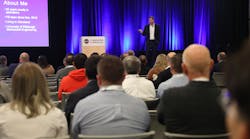It's no secret that the pandemic continues to have lasting impacts on the manufacturing space, and the importance of analyzing these effects cannot be overstated. On the second day of the IndustryWeek Manufacturing & Technology Show, Fortune Brands Water Innovations Senior Vice President Ron Wilson gave a keynote presentation describing how Moen used their leadership to navigate finding business and personal success with their employees.
Leading for Uncertainty
Over the past few years, we've learned that leading for uncertainty sometimes means leading during times of crisis. In addition, Wilson details three key steps:
- Steady the ship: At the beginning of the pandemic, employees were looking for transparency and reassurance. Communication and confidence were crucial in calming workers.
- Get out your serenity bucket: While in these times, there is going to be energized stress, but Wilson mentions the Serenity Prayer: "God, grant me the serenity to accept the things I cannot change, courage to change the things I can, and wisdom to know the difference." He told his team not to focus on the things they can't control "Try to get the organization focused on the things we do have control over and we can make better and optimized even in the midst of chaos," he said.
- Know what you need to navigate: "Give your people what they need to be successful." As an example, he details partnering with the IT team and creating a parallel SAP environment to simulate different scenarios. "We've used data in these last two years more than we ever have before," he said. "We're in a better position now because of it."
Leading for our Employees
To create a connection to your employees, Wilson emphasizes the importance of health and safety plus communication. "Those are the two things we have to get right or nothing else matters," he said. It's not just about following CDC guidelines, it's about engagement and sending a message to your employees. "We wanted them to be able to come to work knowing that the place where they came to work cared about their health, cared about their safety," he said. He states the "We have to walk the talk."
On the communication side, he recalls overcommunicating his steps with employees. As an example, he describes a cross-functional weekly service meeting to provide information on what was going on in operations, subsequently creating a connection. Creativity is also a contributing factor according to Wilson, citing the use of virtual happy hour with your team. Wilson also describes being surprised that remote work allowed for more connection, allowing each other to learn more about their surroundings, home, and personal life.
Leading for our Customers
Wilson describes three pillars to create operational excellence for customers:
- Unite the organization
- Up the focus on quality
- Sustain market leadership
"We are all here to service the customer. One team, one goal, common metrics, common purpose," he said.
"We really doubled down in terms of making sure that we maintained our quality. How you onboard employees ... It was probably my greatest fear or point of nervousness was 'What is this going to look like with all these new employees coming in?'"
Leading for the Future
Moen leads by example when Wilson states that you should not give up on strategy, even in uncertain times. "We built a new retail distribution center outside Columbus, Ohio, during that pandemic. That required a lot of work in terms of moving stuff, inventory, project management. It would have been extremely easy to go like, 'That's going to be a little too tough during the pandemic,'" he said.
Planning for operational uncertainty allows for you to be a step ahead of the competition. "How do you make it a competitive advantage so that when your sales team is out there, when your customers are out there, your supply chain makes a difference?"
Another aspect featured by Wilson was the evolution of performance metrics. He describes moving from standard metrics like cost, safety, service and quality to others such as agility, resilience, labor dependence and speed to pivot; metrics may be different for every business.
The Goal
"At the end of the day, there's nothing like this type of crisis to expose where you can get better," he said. "The goal was not to hide it but to learn from it." With all main points combined, much of the lessons learned from the previous years boil down to one strong conclusion - making customer service your North Star.
To end to session Wilson leaves attendees with a simple yet strong message: "The time is now."





